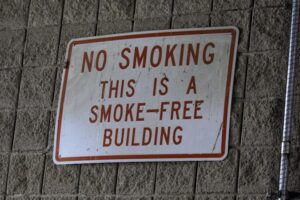BUILDING HEALTHY MILITARY COMMUNITIES TOOLKIT
A RESOURCE FOR THE DEPARTMENT OF DEFENSE HEALTH PROVIDERS AND COMMUNITIES
Policies to Help Service Members and Their Families be Tobacco Free

This section outlines actions to take in collaboration with state and local public health and community organizations to establish more supportive environments for Service members to find and receive help, and to reduce unwanted exposure to secondhand smoke.
Exposure to secondhand smoke from burning tobacco products causes disease and premature death among nonsmokers. There is no risk-free level of secondhand smoke, and even brief exposure can cause immediate harm. Establishing a 100% smoke free environment is the only effective way to fully protect nonsmokers from secondhand smoke.
CDC’s webpage on smoke free environments contains information on secondhand smoke exposure and how to protect Service members and their families where they live, work and play.
The American Nonsmokers Rights Foundation
The American Nonsmokers Rights (ANR) Foundation is a nonprofit group working to create a healthier, smoke free world and to raise a tobacco-free generation. Incorporated in 1984, ANR Foundation creates programs and educational materials to inform the public about the health hazards of secondhand smoke and the health benefits of smoke free air. They have developed a model policy for a smoke free workplace that provides clearly stated intent and specific points of the policy, fosters clear implementation and enforcement, stands up to legal challenges, and achieves the health goal of protecting people from secondhand smoke.
State Health Department Tobacco Control Programs
CDC funds all 50 states and eight territories to implement Comprehensive Tobacco Control Programs. The National Tobacco Control Program webpage provides more information about what each state program is doing, but most states are working on multiple interventions including:
- Tobacco-free policies, including e-cigarettes and smokeless
- Pricing strategies
- Point of sale strategies
- Tobacco 21 (T-21) laws
Smoke-Free Public Housing
On December 5, 2016, the U.S. Department of Housing and Urban Development (HUD) published a final rule in the federal register, Instituting Smoke-Free Public Housing. The rule requires housing authorities administering public housing programs to design and implement a local policy barring the use of prohibited tobacco products in all public housing units, interior common areas, and outdoor areas within 25 feet from residential and office buildings. It prohibits tobacco products including cigarettes, cigars, pipes, and hookahs (water pipes). HUD’s website offers more information on the rule and provides helpful checklists and timelines for public housing authorities and facilities managers.
Cessation Materials from State Tobacco Control Programs
The CDC’s Office on Smoking and Health website contains information for health care providers, health systems, health insurers, state tobacco control programs, and other organizations that plan and fund cessation programs. The resources on this page include best practices, cessation insurance coverage and health system policies, quitlines, and youth cessation approaches.
What you can do:
- Connect with your state’s Tobacco Control Program to discuss ways to collaborate. For an introduction to your state’s Tobacco Control Program Manager, visit the Tobacco Control Network State Directory.
- Share the resources on CDC’s webpage on smoke free environments with Service members’ families, fellow Service members, employers, and local business owners to educate about the health dangers of secondhand smoke exposure.
- Promote ANR’s model policy for worksites with CHIP, SHIP, and other community groups.
- Work with military installation housing offices to require contracted property managers of off-post housing to adopt smoke-free housing similar to HUD’s rule.
